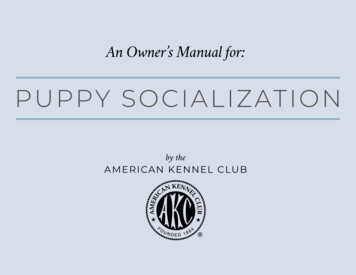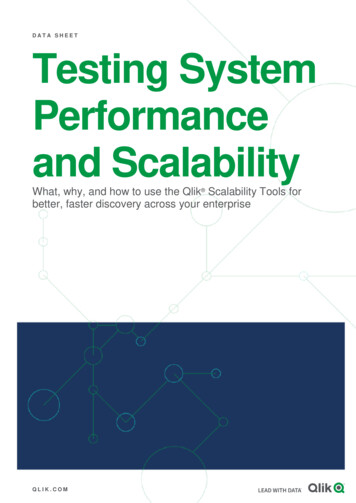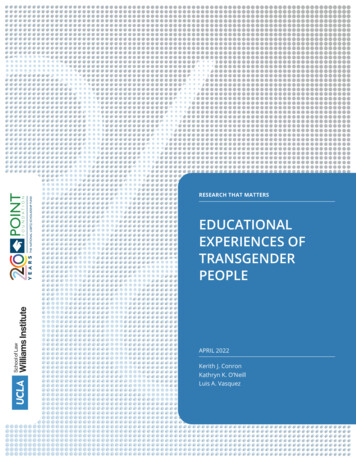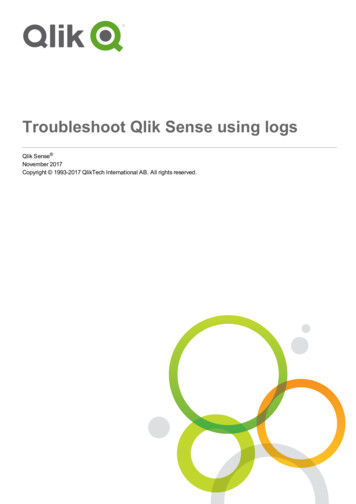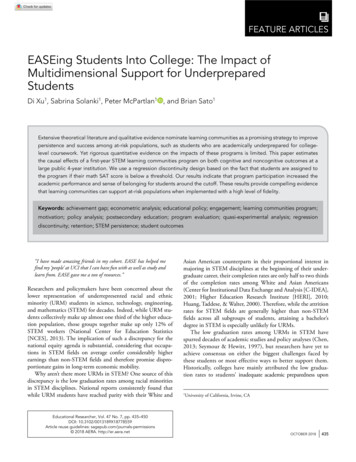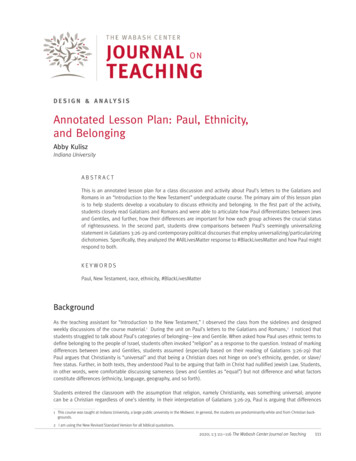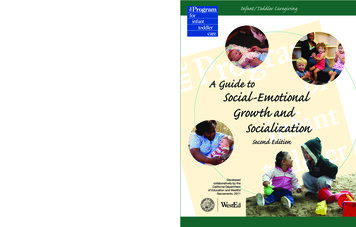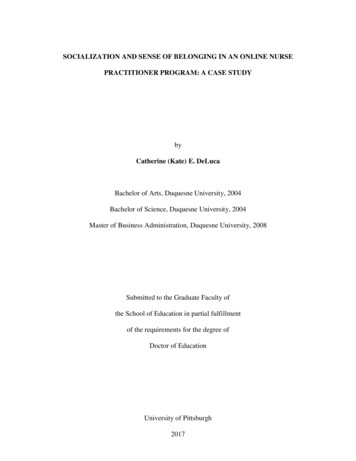
Transcription
SOCIALIZATION AND SENSE OF BELONGING IN AN ONLINE NURSEPRACTITIONER PROGRAM: A CASE STUDYbyCatherine (Kate) E. DeLucaBachelor of Arts, Duquesne University, 2004Bachelor of Science, Duquesne University, 2004Master of Business Administration, Duquesne University, 2008Submitted to the Graduate Faculty ofthe School of Education in partial fulfillmentof the requirements for the degree ofDoctor of EducationTable 4University of Pittsburghi2017
UNIVERSITY OF PITTSBURGHSCHOOL OF EDUCATIONThis dissertation was presentedbyCatherine DeLucaIt was defended onMay 23, 2017and approved byStewart Sutin, Clinical Professor, Department of Administrative and Policy StudiesJohn Weidman, Professor, Department of Administrative and Policy StudiesLinda Goodfellow, Clinical Associate Professor, Duquesne UniversityDissertation Chair: Michael G. Gunzenhauser, Associate Professor, Department ofAdministrative and Policy Studiesii
Copyright by Catherine DeLuca2017iii
SOCIALIZATION AND SENSE OF BELONING IN AN ONLINE NURSEPRACTITIONER PROGRAM: A CASE STUDYCatherine (Kate) DeLuca, Ed.D.University of Pittsburgh, 2017The purpose of this study was to examine the socialization experience of students who wereenrolled in an online master’s level nurse practitioner program. The focus of this study was onthe experience of students in the Duquesne University School of Nursing (DUSON) onlineMaster of Science in Nursing (MSN) Family Nurse Practitioner (FNP) program. Despiteextensive growth in online education and nurse practitioner programs nationwide, little researchhad been done to examine the online graduate programs, specifically the FNP program, and/orgain insight into the student experience (AANP, 2015; Lehman & Conceicao, 2010, 2013).Studies have found that socialization is critical in student development and building sense ofbelonging among students, particularly among students in online programs (Hart, 2012; Holley& Taylor, 2009; Ivankova & Stick, 2007; Strayhorn, 2012).This study used the Weidman, Twale and Stein (2001) theory of Graduate andProfessional Student Socialization and Goodenow’s (1993) theory of Sense of Belonging as theconceptual frameworks. This study also employed a single case study methodological approachand utilized a three-pronged data collection plan that included a document review, survey, andinterviews. Fourteen students completed a modified version of the Weidman, Twale and Stein’s(2003) Doctoral Student Socialization Questionnaire. Fifteen students completed individualinterviews. Results indicated that students’ experiences were positive and that they were able toiv
experience socialization in the graduate student and professional roles. Furthermore, manyparticipants indicated that they had felt a strong sense of belonging to their cohort, despite beingenrolled in an online program. Implications for practice are presented for higher educationprofessionals that include: campus residencies to strengthen cohort bonding, a peer mentoringprogram, and the establishment of a supportive environment in which students feel comfortablecommunicating with faculty and peers and developing their own support systems for success.v
TABLE OF CONTENTSDEDICATION. XIVACKNOWLEDGEMENTS .XV1.0INTRODUCTION . 11.1BACKGROUND ON DISTANCE EDUCATION . 21.1.1Student-centered education . 41.1.2Quality in distance education . 41.2PURPOSE OF RESEARCH . 71.3RESEARCH QUESTIONS . 81.4SIGNIFICANCE OF THE STUDY . 91.5DEFINITIONS AND ABBREVIATIONS. 102.0REVIEW OF THE LITERATURE. 132.1CONCEPTUAL FRAMEWORK. 132.2SOCIALIZATION . 142.2.1Weidman, Twale and Stein’s theory of graduate and professional studentsocialization. 162.2.1.1. Stages of socialization . 192.2.2Socialization in other subpopulations . 212.2.2.1 Graduate students, socialization, and sense of belonging. 22vi
2.2.2.2 African American students, socialization, and sense of belonging . 232.2.2.3. First-generation students, socialization, and sense of belonging . 252.3SENSE OF BELONGING . 262.3.1Defining sense of belonging. 272.3.2Sense of belonging for online students . 302.4SOCIALIZATION ACTIVITIES . 322.4.1Orientation . 322.4.2Campus residency . 332.4.3Advisement . 352.4.3.1 Professional advisement models . 362.4.3.2 Faculty advisement models . 372.4.3.3 Combination advisement models . 382.4.4Outcomes of socialization and sense of belonging . 402.5SOCIALIZATION FOR THE ADVANCED PRACTICE NURSE . 442.6SUMMARY . 473.0METHODOLOGY. 493.1RESEARCH SUBECTIVITY AND PROFESSIONAL KNOWLEDGE . 493.2RATIONALE FOR CASE STUDY DESIGN . 513.3RESEARCH QUESTIONS . 533.4STUDY DESIGN . 533.4.1Setting . 543.4.2Program background information . 553.4.2.1 Orientation . 56vii
3.4.3Population and sample . 593.4.4Recruitment . 593.4.5Consent . 623.53.5.1DATA COLLECTION . 63DOCUMENT REVIEW . 663.63.7INSTRUMENTS . 663.6.1Survey . 663.6.2Interview consent/demographic form . 683.6.3Interviews . 69DATA ANALYSIS. 713.7.1Data analysis plan . 713.7.1.1 Document review data analysis. 723.7.1.2 Survey data analysis. 733.7.1.3 Interview data analysis . 733.8LIMITATIONS . 763.9SUMMARY . 784.0RESULTS AND FINDINGS . 794.1DOCUMENT REVIEW RESULTS. 804.1.1Student handbooks . 804.1.2FNP student blackboard site . 834.1.3Orientation information and materials . 834.1.4. Physical assessment residency week information and materials . 86viii
4.1.5Clinical diagnosis/foundations i residency week information and materials.89SURVEY RESULTS . 955.05.1SURVEY DEMOGRAPHIC AND BACKGROUND INFORMATIONRESPONSES . 955.2CAMPUS RESIDENCY EXPERIENCE RESPONSES . 1005.3PERSONAL EXPERIENCE RESULTS . 1025.4INTERPRETATIONS OF SURVEY RESULTS . 1085.4.1. Demographic and background information . 1085.4.2. Campus residency experiences . 1095.4.3Personal experiences. 112INTERVIEW PROCESS RESULTS . 1176.06.1INTERVIEW DEMOGRAPHIC AND BACKGROUNDINFORMATION .1186.2INTERVIEW RESULTS . 1226.2.1Student experience and perception of online education. 1226.2.2Student experience with the DUSON . 1266.2.3Student experience with faculty . 1356.2.4Student experience with peers . 1376.2.5Socialization to the graduate student and professional roles . 1436.2.6Sense of belonging. 1486.3EMERGENT THEMES FROM THE INTERVIEWS . 1536.3.1The role of the campus residencies . 154ix
6.3.2Moving from “I” to “we” . 1556.3.3Finding ways to connect to their peers . 1586.3.4Socialization and role transition . 1596.3.5A sense of belonging . 1616.4 DISCUSSION OF ALL RESULTS . 1637.0CONCLUSIONS . 1687.1IMPLICATIONS FOR PRACTICE . 1717.2RECOMMENDATIONS FOR FUTURE RESEARCH . 173APPENDIX A . 175APPENDIX B . 176APPENDIX C . 178APPENDIX D . 184APPENDIX E . 186APPENDIX F . 189APPENDIX G . 193APPENDIX H . 194BIBLIOGRAPHY . 196x
LIST OF TABLESTable 1. Definitions . 11Table 2. Abbreviations . 12Table 3. MSN FNP Program Table. 55Table 4. Data Collection Plan . 64Table 5. 2014, 2015, and 2016 Select Orientation Session Results . 85Table 6. 2015 and 2016 Physical Assessment Residency Select Session Scores . 88Table 7. 2014, 2015 and 2016 Select Clinical Diagnosis/Foundations I Residency Session Scores. 92Table 8. Survey Demographic Information (N 14) . 95Table 9. Survey Program Status Responses (N 14) . 96Table 10. Online Educational Experience (N 14) . 98Table 11. Use of Social Technology (N 14) . 99Table 12. Campus Residency Experiences . 100Table 13. Personal Experience of Interaction with Faculty and Students (N 14). 102Table 14. Advantages/Disadvantages of Academic Programs (N 14) . 103Table 15. Student Participation while enrolled in the MSN FNP program (N 14) . 106Table 16. Student Feelings of Support from the School of Nursing (N 14) . 107Table 17. Students Responses to Choosing DUSON again (N 14) . 107xi
Table 18. Interview Responses - Demographic Information (N 15) . 119Table 19. Interview Responses - Program Status and Motivation (N 15) . 120Table 20. Interview Responses - Use of Social Technology (N 15) . 121xii
LIST OF FIGURESFigure 1. Data Collection and Analysis Plan . 65Figure 2. Combined Analysis Process . 74Figure 3. Student Interactions with their Professors . 105Figure 4. Student Interaction with their Peers . 105xiii
DEDICATIONPresident Teddy Roosevelt once said, “Far and away the best prize that life has to offer is achance to work hard at work worth doing.” Several years ago, I stumbled in to higher education,more specifically student affairs, and every day since then I am reminded of why I love what Ido.This dissertation is dedicated to the memory of Dr. Eileen Zungolo, who I could notthank enough for giving me the confidence (and the push) to start this journey. I wish you werehere for me to thank in person.xiv
ACKNOWLEDGEMENTSSo many people have helped me to accomplish this goal. I would like to thank my dissertationcommittee (Dr. Linda Goodfellow, Dr. Stewart Sutin, and Dr. John Weidman) for all of theirinsight, guidance and support during this journey.Your support and expertise helped metremendously. A special thank you to my chair, Dr. Michael Gunzenhauser. Your coaching,direction, encouragement and periodic pep talks made this easier than I thought possible.A very special thank you to Dr. Noreen Garman who early on in my program told me,“You belong here and don’t let anyone tell you otherwise.” Your words have kept me “pressingon” over the years.I would like to offer a special thank you to my parents for teaching me to love school. Iwould also like to thank the rest of my family and friends for their love, support, andencouragement, and for understanding when I was “writing” and could not come out to play.Thank you to my Pitt friends who were always happy to read a draft, offer advice, or justmeet in the back room at Hem’s to support one another. I do not know how some people can gothrough a doctoral program alone and am so thankful that I had all of you.Thank you to my colleagues at the Duquesne University School of Nursing for youradvice, support and encouragement. Finally, thank you to the Master of Science in NursingFamily Nurse Practitioner students for letting me share your experiences.xv
1.0INTRODUCTIONOver the last few decades, distance education, and more specifically online education, has grownexponentially (Lehman & Conceicao, 2010, 2013). Several reasons for this surge have beenidentified, such as the development of technology, improvements to the Internet, and the interestsof a specific population of students who are seeking flexibility when it comes to their educations.The National Center for Education Statistics (2014) reported that, in the Fall of 2012,approximately 26% of all students enrolled in undergraduate and graduate programs in theUnited States took at least one online course. Of that 26%, approximately half were in programsthat were exclusively online (NCES, 2014).As distance education has developed, so has the need to meet the distinct needs of onlinestudents. Scagnoli (2001) posits that, through the inherent nature of distance education, onlinestudents do not have the same experiences as traditional students. As a result, online studentsoften do not make close connections to institutions, faculty, and classmates, thus creatingfeelings of isolation that traditional students are often able to avoid. Because this isolation iscommon and can contribute to student dissatisfaction and attrition, Scagnoli (2001) and Rovai(2002) challenge higher education institutions with the responsibility to create an atmospherewhere socialization and the development of a sense of belonging can be explored by students.1
1.1BACKGROUND ON DISTANCE EDUCATIONThe evolution of distance education over the past two decades has offered advancements inaddressing cost and access barriers for both students and institutions of higher education. Inrecent years, there has been a great deal of legislation and regulation put in to action to addressthe practices of for-profit institutions. Additionally, as the cost of education has risen along withstudent debt, so has the importance of students’ choices of which program or institution toattend. With the general accountability and choice movements associated with higher education,it has become a top priority of higher education institutions to broaden their focus fromtraditional instructional design to one that uses technology as its foundation (Allen & Seaman,2015). While the overall rate of growth for distance education continued to rise at 3.7% in 2014,private, non-profit, four-year institutions saw the most growth at 12.7%, followed by public,four-year institutions at 7.2% (Allen & Seaman, 2015). Both traditional and adult learners areexamining distance education as a mode of access for their coursework or programs. There isstill a debate about the value and academic rigor of distance education, and many institutionsview distance education as a method of expanding course offerings and even campuses. Growthin distance education programs has led to the need for focused research and programming toaddress the needs of the online student population.Students of all demographic backgrounds are attracted by the opportunities that distanceeducation offers (Shea & Bidjerano, 2014). Generally, students benefit from the flexibility ofscheduling classes around their own personal schedules and the ability to take classes fromanywhere (physically); these factors typically attract students to distance education classes or2
programs (Del Valle & Duffy, 2009). Since distance education programs have developed, manystudents have depended on distance education programs as their sole source of education. This isoften due to other access barriers to face-to-face education, such as geographic location,disability, family commitments, professional obligations, and cost, including ancillary studentcosts such as housing and transportation (Del Valle & Duffy, 2009).The student does not reap the benefit of distance education programs alone; universitiesalso benefit from distance education programs. Allen and Seaman (2015) found that the numberof academic administrators that reported the importance of distance education to their long-termstrategic goals rose significantly from 48.8% in 2002 to 70.8% in 2014. Institutions have foundthat not only can they reach a new, broader audience, but they can also be creative with regard topedagogies used in online settings (Del Valle & Duffy, 2009). Through the use of distanceeducation, higher education institutions have found that they can reach students from all over theworld (Rhoads, et al., 2015). Such developments have also meant the growth of revenue streamsvia increases in enrollment, the addition of new programs, and the ability to reach a broaderaudience (Chaney, Chaney & Eddy, 2010; Ozdemir & Abrevaya, 2007). While the evolution ofhigher education and distance education has created opportunities for both the institution andstudent to be successful, there is not enough known about the student experience. Institutionsnow have an opportunity to examine the student experience in an effort to focus strategies onmeeting student needs which leads to further enhancement of experiences (Ali & Smith, 2015;Schaeffer & Konetes, 2010; Swan, 2002).3
1.1.1 Student-centered educationWith the increase in educational options for students, many higher education institutions areseeking to differentiate themselves and stand out. Hadfield (2003) viewed higher education inadult students as a service. Hadfield’s approach has become more widely accepted in highereducation settings where institutions recognize that all learners are making costly decisions abouthigher education and that providing student-centered experiences is key to student satisfaction.Researchers argue that in order to help students to be successful, and in turn to allow for theinstitution to be successful, it is important to focus on a student-centered approach to education(Bowden, 2011; Harrison & Risler, 2015). A key to this approach is the acknowledgement thatstudents have choices in the selection of educational programs and that the quality of theeducation is a determining factor (Bowden, 2011; Harrison & Risler, 2015). Additional factorsthat help potential students make decisions include: support services, welcoming environments,strong focus on student needs, and the overall experience (Crawley, 2012; LaPadula, 2003).Some researchers suggest that creating opportunities for socialization and an environment thatsupports building a sense of belonging between the student and the institution is a critical step inaccomplishing this goal (Boling, Hough, Krinsky, Saleem & Stevens, 2012; Gallagher-Lepak etal., 2009; Restauri, 2004; Rovai, Wighting & Liu, 2005; Strayhorn, 2012).1.1.2 Quality in distance educationIn 2001, the Online Learning Consortium, formerly known as the Sloan Consortium, developed aframework that focuses on five pillars critical to establishing quality distance education. Thefive pillars focus on access, scale, learning effectiveness, faculty satisfaction, and student4
satisfaction (Moore & Shelton, 2014; Porto, 2014). These pillars are the basis of the QualityScorecard for the Administration of Online Education Programs, which was developed from bestpractices to benchmark online programs for quality. Each pillar has quality indicators that speakdirectly to the goals and objectives of the pillar and offer suggestions to meet the standard. Forexample, the student satisfaction pillar presents many quality indicators to address specificmeasures linked to positive student experiences that lead to student satisfaction (Moore &Shelton, 2014; Porto, 2014). These indicators include such measures as: Program demonstrates a student-centered focus rather than trying to fit supportservices to the distance-education student in on-campus student services; Students should be provided a way to interact with other students in an onlinecommunity; Efforts are made to engage students with the program and institution; Students are instructed in the appropriate ways to enlist help from the program.(Moore & Shelton, 2014, pp.47-48)By using this scorecard as a guideline, institutions can improve students’ online experiences.Institutions strive to create a sense of belonging for online students by focusing on key strategiessuch as socialization to the role of the graduate student, the institution, and the program (Moore& Shelton, 2014; Porto, 2014). Crawley (2012) and LaPadula (2003) found that students whobelieve they are supported and have a more positive experience are more likely to persist,graduate, become satisfied alumni, and possess a sense of belonging to the institution.5
While students are able to socialize and develop relationships and a sense of belonging atsome level, the university has a responsibility to support students and offer opportunities forthem to engage with others and the institution (Sweitzer, 2009). The greater the sense ofbelonging a student feels for the institution, the greater the chance of the student completing hisor her degree and feeling a sense of loyalty to the institution (Hoffman et al., 2002). Elliott andShin (2002) also attribute student satisfaction to socialization through the consistent and ongoinginteractions between students and their institution, and instructors and their peers. This holds trueparticularly for online programs (Crawley, 2012; LaPadula, 2003).Socialization is an essential part of both student development and building sense ofbelonging among students. An abundant amount of research has been conducted focusing onsocialization and sense of belonging in students. More specifically, a large amount of researchhas been conducted focusing on the sub-populations such as graduate students, first-generationstudents, and African American students.While there have been a few studies that wereconducted with online nursing students that focused on socialization, they were specificallyfocused on those in doctoral programs (Billings, 2000; Broome, Halstead, Pesut, Rawl andBoland, 2011; Goodfellow, 2014; Halter, Kleiner and Hess, 2005). The research on onlinedoctoral nursing students is beneficial to studying other online nursing students; however, in myreview of the literature, I was unable to find any studies that addressed socialization and sense ofbelonging in online master’s level nursing students. This study is an attempt to fill this gap inthe literature.6
1.2PURPOSE OF RESEARCHThe purpose of this study is to examine the socialization experience of students who are enrolledin an online master’s level nurse practitioner program. The focus of this study is on theexperience of students in the Duquesne University School of Nursing (DUSON) online Master ofScience in Nursing (MSN) Family Nurse Practitioner (FNP) program. The primary goal is toexamine the experience of the students in this specific professional program so as to gain an indepth perspective of a socialization experi
SOCIALIZATION AND SENSE OF BELONING IN AN ONLINE NURSE PRACTITIONER PROGRAM: A CASE STUDY Catherine (Kate) DeLuca, Ed.D. University of Pittsburgh, 2017 The purpose of this study was to examine the socialization experience of students who were enrolled in an online master's level nurse practitioner program. The focus of this study was on


